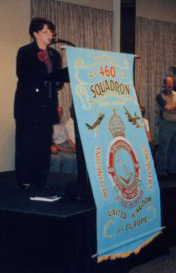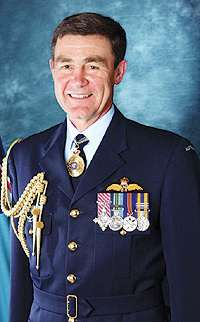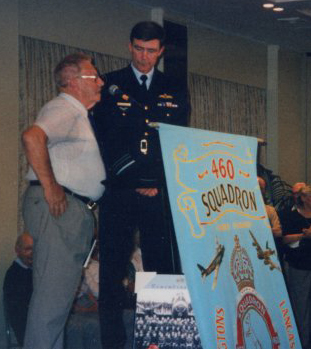
The Hon the Minister of Veteran Affairs, Danna Vale, MP
The Hon the Minister of Veteran Affairs, Danna Vale, MP Speech

In introducing The Hon the Minister of Veteran Affairs, Danna Vale, MP. Mr Laurie Woods referred to the squadron members as walking museum specimens.
Minister "Thank you Laurie, you are not walking museum pieces at all, each and every one of you is a National Treasure.
Ladies and Gentlemen I would like to acknowledge the Chief of the Australian Air Force. Angus Houston, Mr. Laurie Woods, President of 460 RAAF Association for Queensland and Mr. Joseph Brown, Secretary of the Queensland branch, Members of the 460 and other squadron associations, and the women who love them.
It is a real privilege and an honour for me to be here tonight to welcome you all to Canberra for this very special National Reunion of 460 Squadron Association.
This year's visit will be a particularly special gathering, with the unveiling of the magnificently restored G for George at the Australian War Memorial next Saturday.
I know that many of you will have fond memories of G for George and other Lancaster bombers that you flew during World War II. G for George has a special place in the hearts of many Australians and I know that he has been missed during his absence from the Australian War Memorial.
For the past five years, G for George has been undergoing a million–dollar conservation project aimed at ensuring that this historic aircraft continues to be a feature of Australian wartime history and collections. Restoration is now complete, G for George will make a spectacular return to the Australian War Memorial.
The new exhibition, Striking by night, will feature a stunning integration of light and sound, simulating a night operation that took place over Berlin, on the 16th December, 1943. Nineteen Lancasters of 460 Squadron took part in that mission, during which four were lost, crashing on their flight home, in appalling weather conditions.
The exhibition will give visitors an understanding – even though a small understanding – of the dangerous and frightening experiences that you and your mates encountered during bombing missions over Europe when you were so very very young and very very brave. Modern technology will try to recreate the blinding searchlights, the flares, the anti–aircraft fire and the fighter attacks.
The exhibit will be a tribute to you and especially those from your squadron who did not make that flight home.
I welcome you all to Parliament House tomorrow morning and I do look forward to joining you on Saturday at the Australian War Memorial for the unveiling of our magnificent G for George.
Air Marshall Allan Grant (Angus) Houston, AM, AFC speech

"Minister for Veteran Affairs the Hon Danna Vale, Mr Laurie Woods, President of the 460 squadron Association in Queensland, Members of the 460 squadron Associations from all over Australia, and from England.
Ladies and Gentlemen. It's my great pleasure to be here this evening, in fact it's a great honour to be with members of our great Air Force generation. You are the people that took the tradition that was established in WW1 and strengthened that tradition with what you achieved in WWII. What I want to do is just talk a little bit, how we, in the current day Air Force, regard you, because it is very important that you understand that, but before I do that, I thought it was also important to say that I really also appreciated all the nice compliments about my youthfulness here tonight. What I normally get when I go to a gathering of aircrew, because they are all so young, is quite the opposite "Who's this old shellback" so I am absolutely delighted to be here. I am deeply impressed with how good you all look , you're doing really well and if I am doing just as well at your age I will be absolutely delighted.
Let me say about what is important with what is happening here with your reunion. You are probably not going to have too many more reunions of this kind and I think it is very important and I think it is very important that you hear from the Chief of the Air Force how we regard what you did. Nobody did more to win the war in Europe than did the Australian members of Bomber Command. You took up the fight to a very determined enemy, you flew with great courage night after night, to destroy the German war time economy, you slowed the development of the V1 and V2 rockets with your raids on those rocket factories in Germany.

In the build up to the Normandy landings you destroyed the German transportation system, thereby enabling the great victories and the great campaigns of 1944 and 1945 and particularly the "D" Day landings in Normandy. You also tied down about a million of the German people in providing an air defence against your very effective bombing campaign. Albert Spear, one of the Reich leaders at that time said "Bomber Command's victory, represented the greatest lost battle on the German side" Gentlemen you were part of that great victory, and I know that great victory was won at incredible cost. A cost that we can only wonder about today. A lot of people don't understand that of the enlisted people in the Australian services, people that went off to world war2 and of these 2% went off to Bomber Command and of that 2% they sustained 20% of those killed in action. I would like to pause for a moment for us to remember those of your number who didn't come back, both in 460 squadron, the other Australian squadrons, and of course that vast body of men that flew with the Royal Air Force.
In terms of individual units there has never been a more outstanding unit in the Australian Air Force the no. 460 squadron, I can say this quite definitely. You flew more sorties, you dropped more bombs, you got more decorations, and regrettably you sustained the highest casualty rate of any Australian Air Force unit in our history, 1018 of your number did not return. I deeply regret that but I think it represents a level of service, a level of sacrifice that we really admire greatly in the modern air force. We are astounded in what you were able to achieve in those Wellington and Lancaster bombers from way back in the 1940s. It wasn't easy those aircraft were much more unreliable than the aircraft we fly now.
You all experienced being shot up many times with engine failures, but you always flew with a great professionalism, you demonstrated a high level of operational initiative and always you flew with great team work and a great sense of humour. I just want to pay a tribute to all of you for what you achieved for Australia. Also I think it is important to recognise the great work that you did when the bombing campaign was finished. The food drops that were carried out to relieve the starving Dutch people in the Winter of 1944/45 probably the worst Winter that Europe has ever experienced, and without your sustenance from the air the Dutch people would have been greatly affected and in fact many of them would have died. My own father was a prisoner of war, he was in Staluglufte 3 and he and many others were flown home in Lancaster bombers that went over at the end of the war to pick up POWs.
In conclusion I would like to say this;
We greatly admire you and on behalf of the members of the Australian Air Force just like to say the following;
We thank you for your service,
We admire your achievement,
We respect your values,
We salute your courage,
We honour your sacrifice,The feats of 460 squadron and the valour of her crews are an inspiration for those of us who serve today,
We will never forget you.